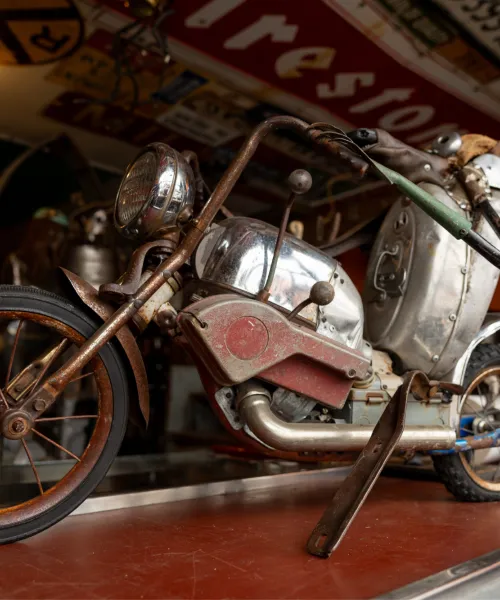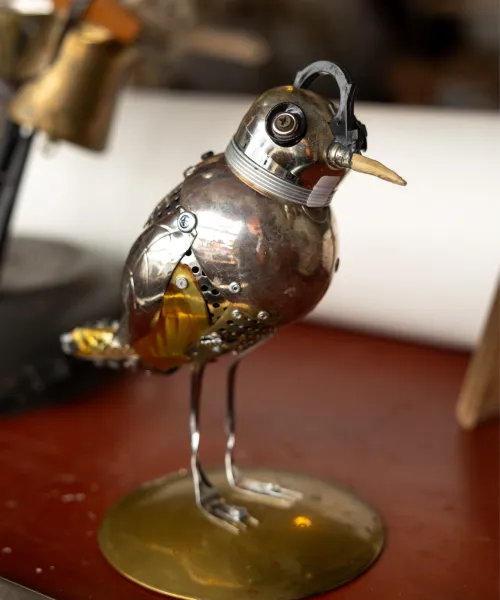By Nicholas Jones '22 BS
Ritch Branstrom ’91 BFA, ’93 MA has spent his career turning almost nothing into something, making art from found objects, or for lack of a better term, trash.
Almost everything Branstrom uses in his work is made from recycled materials. Tin cans, pieces of boat engines, old fire extinguishers, forks and spoons and so much more. He draws from the environment for materials and inspiration but does not make his art to showcase sustainability. He does it because it makes him happy.
He has many works scattered throughout the Upper Peninsula and beyond, many of them larger than life. He constructed the tire worms at Picnic Rocks, worked with kids to make the dinosaur at the U.P. Children's Museum and has crafted many signs for area businesses, including the Blackrocks Brewery sign.
“The original Blackrocks sign, the oval, I believe is one of my greatest works ever, because it was my collaboration with Mother Nature. Winter has always been a struggle for me, but when I started on that, I filled it with water, and made it with freeze expansion. I had to freeze and thaw it eight times to get the expansion that came out on that. It made me excited about winter.”
Growing up in Taylor, Michigan, where his father, a product of the Great Depression, was a mechanic, Ritch would create his own toys, such as a covered wagon made from his Radio Flyer and aluminum pieces from lawn chairs.
“In Taylor, every Saturday was garbage day and people put all their stuff out and I was never allowed to pick anything out of other people's garbage,” he recalled.

That changed when the family moved to the U.P. “I had an uncle up here, and his yard was full of cars and tractors and stuff. My mother hated that, but for me, Uncle Ernie was a huge influence because he was also able to make something out of nothing.”
Branstrom went on to Bay College and then Michigan Technological University for electrical engineering. But he “ended up being kicked out for having the worst grades on campus.”
“I was lost, I was absolutely lost. I wasn’t making art. I was really trying to apply myself, but things were not clicking. Also, that was my first time truly away from home.” So he went back home and helped his brother build a house for a neighbor and then signed up at NMU for art school, even though he didn’t know what path he would take.
“The first person I met was professor Tom Cappuccio and he said, ‘We’ll sign you up for illustration,’ because he was the instructor. But I am a 3D person and once I discovered the Birds’ Eye Art Annex, that changed everything for me. They had just started up a new program—product design—which encouraged you to take every studio course. That was a tailored fit for me. I never looked back from there. I had a 4.0.” He continued on at Northern to get his MA and to teach the classes he had taken.
Since then, he has been working on art full time, most recently at his studio in a former grocery store near the shore of Lake Michigan in Rapid River. In it, you will find many birds, fish, deer made from tin cans, forks and scrap metal. There are statues of people including Father Marquette, musicians, religious figures and even himself that are constructed with old fire extinguishers, pieces of boat engine, coffee cans and even parts from broken down rifles.
He traveled extensively for art shows, taking as much as he could to fill up his ten-by-ten booth. But later stopped traveling as he was starting a family. He eventually got turned off by the fact that we live in a throwaway society, which he did not want
to contribute more to. “If a single piece of the system breaks, we throw it away and buy another. This is one of the biggest problems we face as a society. We are consuming ourselves off the face of the planet.”
Compounding these thoughts and his habit of picking up objects, an idea was formed.
“The beach is my church and refuge. Whenever I go, I pick stuff up, whether it is trash that shouldn’t be on the beach or if it’s something I can use. Often I would forget a bag, so I decided to use my skills to make something to collect objects from the beach and the waterways.”
His invention is shaped like a fish, with a ballast in the back where you can place a beverage or a pair of gloves or such. The head is made of a license plate that is formed over, and it has a mouth made from a smashed tin can with a piece of recycled rubber that makes the mouth self-closing. “So, recycled material, recycled material, recycled material… and this cage material is available at any hardware store. This is one of the most efficient products I have ever made because there is little to no waste.”

with a ballast in the back where you can place a beverage or a pair of gloves or such. The head is made of a license plate that is formed over, and it has a mouth made from a smashed tin can with a piece of recycled rubber that makes the mouth self-closing. “So, recycled material, recycled material, recycled material... and this cage material is available at any hardware store. This is one of the most efficient products I have ever made because there is little to no waste.”
He said the fish device is really interactive and fun to use, and it can be used by everyone. He is trying to make them more affordable and easier to produce, as it takes a good day’s work to make just one. He is apprehensive of his idea being replicated in a way that takes away from the sustainable and efficient process. However, he also wants to get them into the hands of as many people as possible.
Branstrom received many positive reactions when his invention was on display at a local festival. He had two of
the fish, one empty and one filled with beach objects. While he had been playing with the theme of animals with trash in their stomachs for years, either with plexiglass or wired bellies, he was surprised that multiple people wanted to purchase the trash-filled fish, to display as an art object, and realized beach trash is actually a valuable commodity.
“The Covid period really helped me take a step back and appreciate the value in all of this. I think human creativity is our number one resource. But our modern American culture doesn’t value the arts—or education—all that much. If there was more investment made in creativity we would be in a better place. This is what can save the world because it speaks a universal language and you
do not have to speak English to appreciate this. It doesn’t matter your nationality, it doesn’t matter your age. We need to respect our life support system.”
Experience Ritch Branstrom’s works at adhocWORKshop on the web, Instagram and Facebook.

